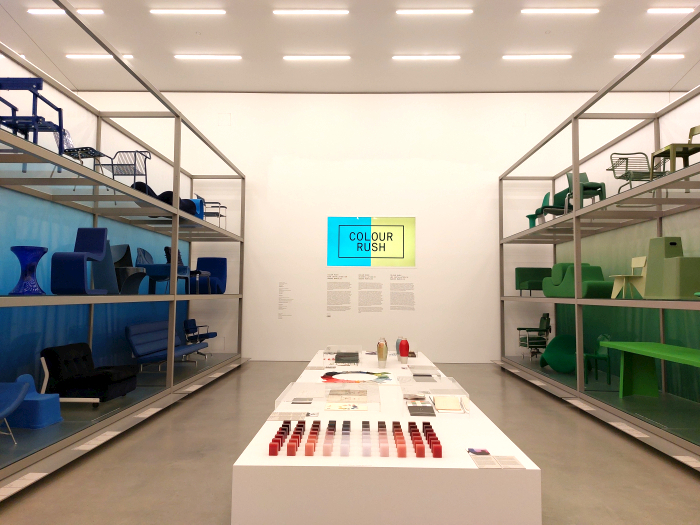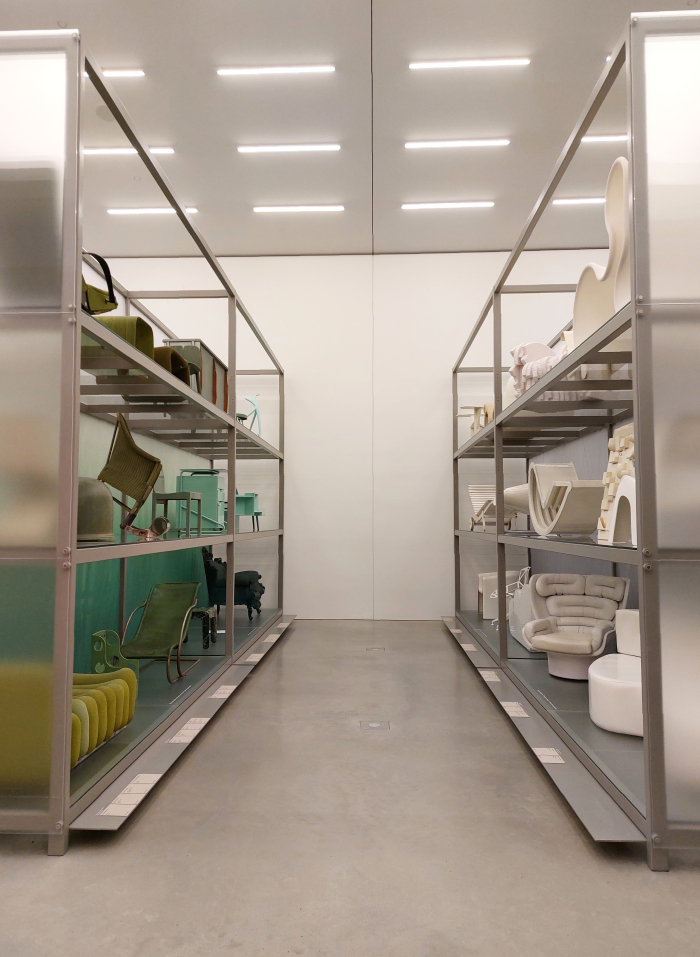Colour Rush! An Installation by Sabine Marcelis at the Vitra Design Museum Schaudepot, Weil am Rhein
Amongst the many developments that have influenced and informed the path of furniture and interior design in the past 120ish years one must, without question, count developments in context of colour.
Whereas in previous centuries colours were limited in their availability, range and durability, recent decades have seen not only progress in that availability, range and durability, and as such ever more possibilities in our use of colour, but also seen increasing study of psychology and colour and of developments in understandings of human perception of colour, ever increasing appreciations of how colours exist beyond the physical and chemical. And an ever increasing use of colour in marketing, a creeping commercialisation of colour.
With the installation Colour Rush! Rotterdam based designer Sabine Marcelis transforms the Vitra Design Museum Schaudepot into a space for differentiated considerations on colour and our furniture and interiors, on the colours of our furniture and interiors. And in doing so also allows for some fresh insights not only into the Vitra Design Museum collection, but what that collection can teach us all about furniture and interior design over the past 120ish years…….
The basis of the Vitra Design Museum collection is and was former Vitra CEO Rolf Fehlbaum’s collection of not just furniture and lighting, but also toy robots, a collection which in 1989 became the Vitra Design Museum and since when has grown into a treasury of some 7000 furniture objects, 1000 lighting objects, and some 1000 toy robots, in addition to a myriad other objects of daily use of all genres. Most of which invariably spend the greater part of their time on shelves in storerooms. And as noted from Wilhelm Wagenfeld A to Z at the Wilhelm Wagenfeld Haus, Bremen, objects in any design museum storeroom are essentially worthless in terms of contributing to the advancement and development of popular understandings and appreciations of design and design (hi)story. For that they need to be on show.
With the opening of the Schaudepot in 2016, the Vitra Design Museum created space for a permanent collection exhibition, and thus an opportunity to allow at least part of that collection to serve the function a piece of furniture takes on when it enters a museum, the function a piece of furniture swaps for its original function when it enters a museum. A permanent collection exhibition expanded by three annual showcases within the Schaudepot which employed the wider, still storeroom tethered, collection for thematic and monographic exhibitions, including, and amongst many other showcases, Gae Aulenti: A Creative Universe, Hans J. Wegner: Designing Danish Modern or Living in a Box. Design and Comics. Before in 2021 with Spot On: Women Designers in the Collection the Vitra Design Museum initiated the staging of a year long special exhibition within the Schaudepot; a year long special exhibition not just staged within the Schaudepot but which intervenes in the permanent collection exhibition, appropriates the permanent collection exhibition for its own ends, and in doing so re-organises and re-curates the permanent collection exhibition.
With Spot On that re-curation saw the number of objects by female designers, and number of female designers, in the permanent collection exhibition increased as part of, as an embodiment of, a, we hope still ongoing, attempt on the part of the Vitra Design Museum to correct imbalances and skews in the collection and that collection’s representation of design (hi)story; while for Colour Rush! Sabine Marcelis has arranged, organised, curated, the permanent collection exhibition not just anew but according to colour. Has, if one so will, created a rainbow within the Vitra Design Museum Schaudepot.
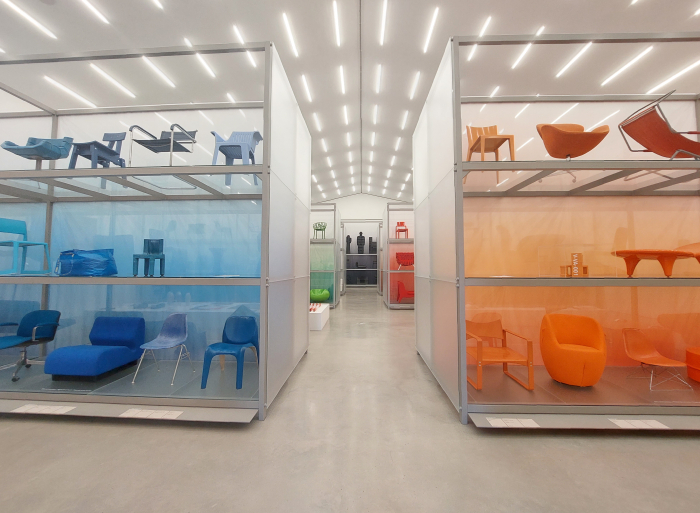
Entering the rainbow, as seen at Colour Rush! An Installation by Sabine Marcelis, Vitra Design Museum Schaudepot, Weil am Rhein
Not an exact rainbow.
On the one hand, while all the relevant colours are present, not in the familiar order. And there are two additional colours: brown and silver. The former essentially, but not exclusively so, woods, in their natural states as represented, for example, by the bent beech of a Thonet 14 side chair, the woven rattan of Egon Eiermann’s E10 lounge chair, the moulded birch plywood of Caroline Schlyter’s Lilla h side chair; or the encased, trapped, maize kernels of Alessandro Mendini’s Grano side chair. The silver essentially, but not exclusively so, metals in their natural states including, and amongst other works, Harry Thaler’s Pressed Chair for Nils Holger Moormann, a chair pressed from a single piece of aluminium sheeting; Muller van Severen’s Wire S #4, a recreation of a bowed mattress crafted from steel wire as a lounger; Fiche Mâle by Yonel Lébovici, an oversized two-pin plug in aluminium as a floor lamp, the pins being tube lighting; or Alfred Zeffner’s early 1930s GT 74 bar trolley which introduces chrome plated steel tubing.
In addition to the two non-rainbow colours Colour Rush! also features three non-colours: white, black and transparent, the latter as represented by, for example, a 1930s table by Jacques Adnet and René Coulon where top and legs are crafted in glass; Estelle & Erwine Laverne’s 1950s acrylic glass Lily lounge chair, a deliciously alluring object that almost has something Disney-esque about it; or Philippe Starck’s polycarbonate Louis Ghost armchair for Kartell from 2000. And thus a presentation which also neatly underscores, makes transparent, how the development of novel materials enables designers to achieve the same results in ever more efficient, practical, cost-effective and durable manners.
And a rainbow extended and supported by leprechauns brief discussions on the colour approaches and understandings and practice of Albert Henry Munsell, Le Corbusier, Alexander Girard, Verner Panton, Hella Jongerius and Sabine Marcelis, and thus protagonists of various hues, pun intended, from across a century and a half of developing relationships with colours; and brief discussions which allow one to go beyond colours and into the classification of colours and the manners via which we seek to standardise and organise colour.
Much as Sabine Marcelis has organised colour in Colour Rush!; albeit whereas conventional organisings of colours tends to restrict and limit appreciations of colour, of what colour is and can be, Marcelis’s organisation allows one to broaden and deepen your appreciations of colour, specifically in context of colour, furniture and interior design.
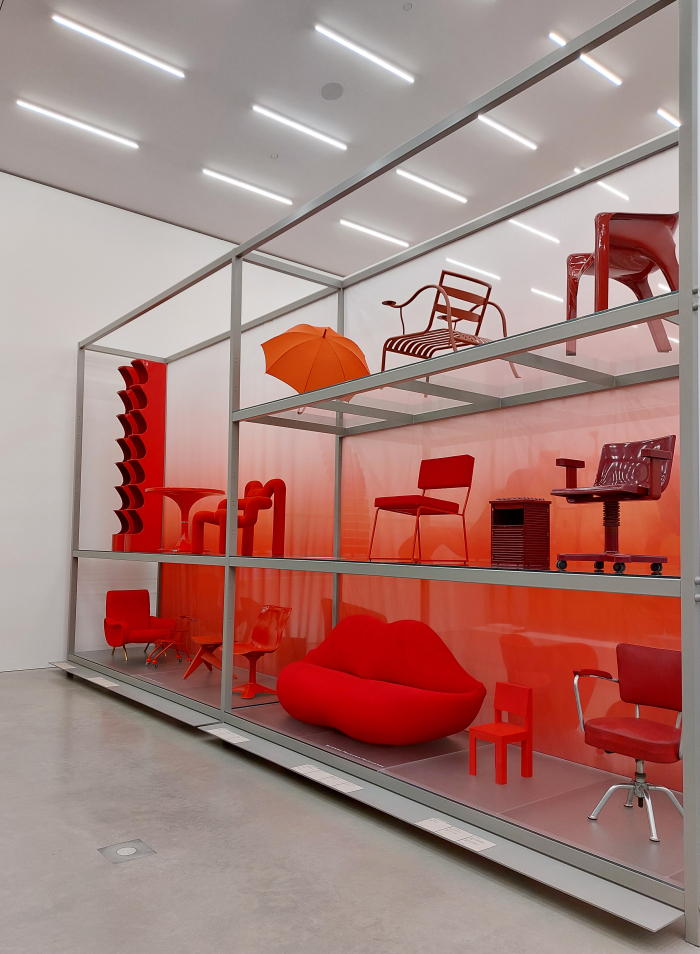
Works in red, as seen at Colour Rush! An Installation by Sabine Marcelis, Vitra Design Museum Schaudepot, Weil am Rhein
Verner Panton once famously claimed that one sits more comfortably on a colour you like. Which clearly isn’t true. But also very clearly is true, if, as discussed, for example, in context of Color as Program. Part One at the Bundeskunsthalle, Bonn, colour unleashes, is associated with, certain impulses and emotions and associations. That colour can be, ¿is?, a component every bit as important in the response of an individual to any given work as the material from which it is crafted and the nature of the interaction.
And a question Colour Rush! allows one to approach through the many very familiar objects it presents in relatively unfamiliar hues: is, for example, Hans J. Wegner’s Ox Chair less dominating, less daunting, in yellow than ox brown?; is De Pas, Lomazzi, D’Urbino & Scolari’s Blow inflatable lounge chair more permanent, less transient, in pink PVC than in crystal clear PVC?; or while a Purple Heart is a medal you, arguably, would sooner not receive, is a purple Heart Chair by Verner Panton preferable to the red version? Similarly were Studio65’s Marilyn sofa not in its familiar vibrant red of cherry chapstick lips as presented in Colour Rush! but in a ghostly light blue, would it find an echo? Apart from amongst Goths.
Considerations which also lead one to questions of why furniture objects are the colours they are.
As Colour Rush! helps elucidate, some objects have a very direct relationship with their colour: Amadou Fatoumata Ba’s Pouf Tressé, for example, is black because it is crafted from recycled tyres; Marcello Pietrantoni and Roberto Lucci’s Nuvola lamp is white because an idealised fluffy white cloud makes for a better lamp than an idealised black storm cloud; Alessandro Mendini’s Lassù side chair is black because Mendini set it on fire. And the 1940s Bush television is brown because that’s the natural colour of Bakelite, similarly the 1973 experimental model of Verner Panton’s eponymous plastic cantilever chair is smokey brown because that is the natural colour of polycarbonate. Crystal clear polycarbonate and coloured polycarbonate being more recent developments. And which in Colour Rush! can be compared with the natural brown through Philippe Starck’s aforementioned crystal clear polycarbonate Louis Ghost and Karim Rashid’s rosé polycarbonate Poly side chair for Bonaldo.
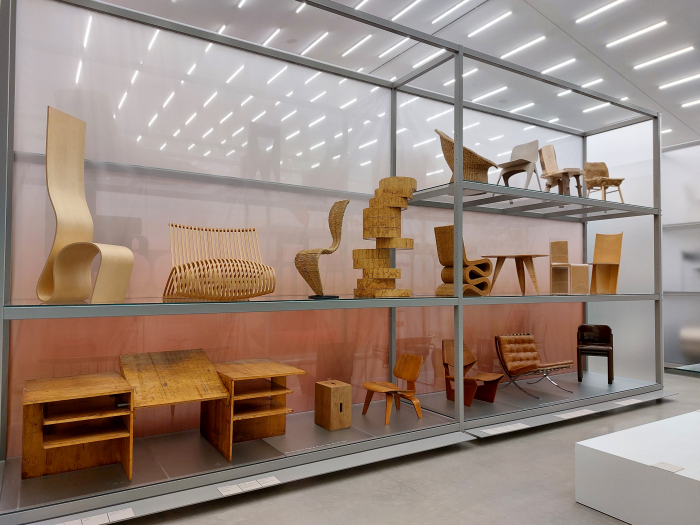
Works in brown, as seen at Colour Rush! An Installation by Sabine Marcelis, Vitra Design Museum Schaudepot, Weil am Rhein
Other objects have more conceptual relationships with their colour: while, for example, the variegated brown of George Nakashima’s Conoid Bench is, yes, on account of the grain and irregularities of the American black walnut, that it is so, and not, for example sanded to a unity or painted, is primarily related to Nakashima’s understandings of relationships with nature and his approach to materials, his use of wood as something to be worked with rather than worked, wood as a partner more than a commodity, and his championing of craft production and the unicum, and that in a late 1950s America of industrial production, fibreglass and ever new synthetic plastics in ever brighter colours; we’re not calling the Conoid Bench an act of resistance but it is certainly audible support for an alternative. That Hauke Odendahl’s Union Chair is blue is because it is an interpretation and representation of the European Union in chair form, and thus in EU blue; Jasper Morrison’s Thinking Man’s Chair is red because Morrison painted the first one in a red oxide paint by way of rust-proofing, and thus a colour chosen, as Morrison states, because it was “functional rather than decorative”; while mischer’traxler’s Idea of a Tree is variegated green because it was woven by an autonomous machine which weaves faster or slower depending on the intensity of the sun during the course of a day, thereby leaving behind thicker or thinner piles of yarn and meaning that along its length it undulates in terms of form and colour intensity.
However, viewing Colour Rush! one is very much aware that the vast majority of the objects on show have no relationship with their colour; rather are that colour because someone decided they should be that colour. A colour that in a great many cases is but one of many in which the object is/was available, the majority of the objects could be just as easily placed elsewhere in Colour Rush!, if that is the Vitra Design Museum collection possessed them in other colours. And indeed Naoto Fukasawa’s 2007 Chair is found twice, in crystal clear acrylic glass and in orange polyurethane, in addition to existing in the Vitra Design Museum storeroom in a myriad other materials and colours.
But who decides what colours are available when a furniture object doesn’t posses an innate colour? And on what basis?
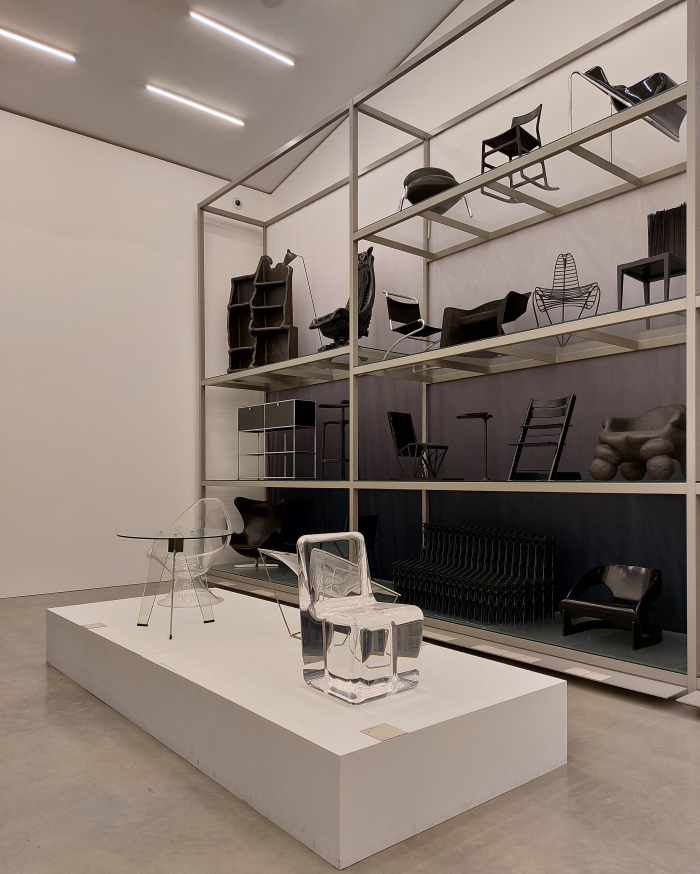
Chair by Naoto Fukasawa in acrylic glass, as seen at Colour Rush! An Installation by Sabine Marcelis, Vitra Design Museum Schaudepot, Weil am Rhein
Questions only very rarely posed, we all tending to unquestioningly accept that which is offered, yet questions that should, must, be posed, and that not least because colour isn’t a passive component of the worlds we occupy; one can agree with or dismiss the myriad psychological associations bequeathed upon colours, but one can’t deny that we all have individual relationships with colour, have preferences and partialities and antipathies.
Can colours create well-being?1 asked once Verner Panton, or to rephrase Panton’s above claim, while one may or may not sit more comfortably on a colour you like, does one live more comfortably in a colour scheme you like?2
Inarguably yes.
But do we decide what we like in terms of the colours of our furniture and interiors, or do we decide which of the available colours we like most?
And who decides what colours are available when a furniture object doesn’t posses an innate colour? And on what basis?
Or as a Bernat Klein once asked in terms of textiles, “where do colours come from and why? And where do good colours go when they die?” Where? And where?
Who decides what colours are available when a furniture object doesn’t posses an innate colour? And on what basis?
And can you colour any given piece of furniture in any colour? Is an Amédée Ozenfant wrong when he opines that “colour always modifies the form to some extent”? Does form follow colour? Can a colour impact negatively on a piece of furniture? Would any given object in Colour Rush! present itself with the same character if represented across the rainbow?
Who decides what colours are available when a furniture object doesn’t posses an innate colour? And on what basis? It’s your worlds they’re colouring.
Have you ever considered why any given furniture object is the colour it is? Have you ever considered if a colour is appropriate for any given furniture object? Is colour a function? Or do you not care about the colour, it’s the object that’s important. What is the role of colour in context of furniture? What is the role of colour in context of the furniture industry? How has that changed over the past 120ish years?
Through shifting the focus of a furniture collection from the objects to the colours, Colour Rush! is an open invitation to begin both posing such questions and also for reflecting on where a century and a bit of advances in colour technology have brought our relationships with colour, collectively and individually.
A shift of focus from object to colour, a curatorial concept, which also enables Colour Rush! to allow the Vitra Design Museum collection to present perspectives of itself that are normally unobtainable.
A curatorial concept which forces all manner of unfamiliar juxtapositions; throughout the presentation one finds objects that you would never normally find near one another, but which stand in happy, and informative, dialogue with one another. The juxtaposition, for example, and amongst many others, of Amadou Fatoumata Ba’s aforementioned Pouf Tressé with Dirk van der Kooij’s ever joyous Chubby Chair allowing for two takes on recycling, one using the material as it is, the other deconstructing it and then reforming it. Friedrich Jakob Kiesler’s 1930s rustic wooden desk and Le Corbusier’s 1950s rustic wooden stool, height adjustable box, for the Pavillon du Brèsil at the Citè Universitaire, Paris, offering an alternative perspective on analogue technology in the contemporary agile, active, office, reminding that it needn’t always be high-tech. Peter Solomon Design’s monobloc Altra-ergo and its neighbour, Marcel Breuer’s tubular steel B 34, reminding that furniture design is often more about developing processes by which to create objects than developing actual objects. While the proximity of Nakashima’s Conoid Bench and Thonet’s Chair 14 forces you to consider why the latter is brown.
A curatorial concept which also allows a lot of works, and a lot of designers, who would, potentially, have been overlooked in a, let’s say, classically curated permanent collection exhibition, to make an appearance; we were particularly thankful of the opportunity to meet, and amongst many other works, Estelle & Erwine Laverne’s aforementioned Lily lounge chair, Beat Frank’s La Tourette chair or Yrjö Kukkapuro’s No. 415A swivel chair, a work which very much resembles a Cubist duck, and which tends to underscore Kukkapuro as one of the more idiosyncratic 20th century furniture designers, a designer who elucidates that design from Finland is so much more than the easy familiarity of the Aaltos bent birch, and a designer who deserves to be known for more than the lounge chair that so popularly represents him.
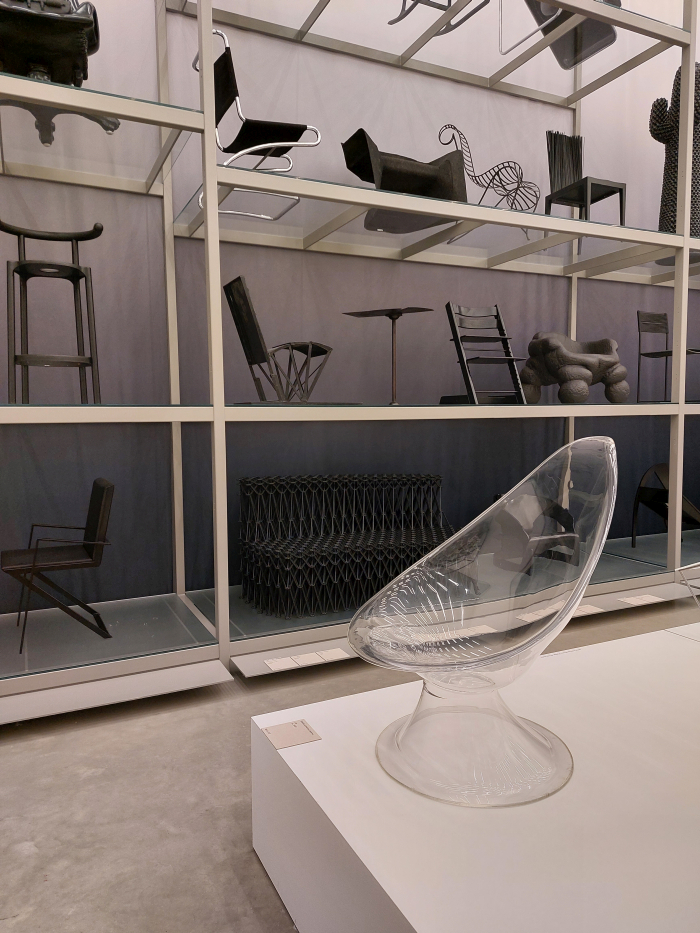
Lily by Estelle & Erwine Laverne, as seen at Colour Rush! An Installation by Sabine Marcelis, Vitra Design Museum Schaudepot, Weil am Rhein
And a curatorial concept which also allows for the presentation of innumerable unfamiliar works by very familiar names; Colour Rush! featuring an awful lot of only very rarely seen works by the likes of Charles and Ray Eames, Alessandro Mendini or George Nelson, more probably George Nelson Associates, but a presence of George Nelson (Associates) which genuinely helps expand appreciations of the oeuvre of George Nelson (Associates). And which in the form of the 1940s stool No. 4672 with its small carrying handle/bag hook as a statement of an ambition to grow a full size backrest, plays beautifully with the (hi)story of the back-stool via which stools of yore became contemporary side chairs. A work that could be launched tomorrow and would not only excite but be a fresh impetus. And a work that were it not for Colour Rush! would be sat on a storeroom shelf, twiddling its thumbs.
Colour Rush! also presenting a lot of rarely seen works by Verner Panton, a designer who, as one can well imagine, pops up, pun again intended, in near every colour, save the white which he famously once opined should be subject to an extra tax. While his mid-1950s crystal clear acrylic glass lounge chair reminding that he was so much more than the colour for which he is popularly known. And also reminding that crystal clear, transparent, furniture isn’t; but rather takes on the colour of that which is around it, and continually changes colour depending on the context and position in and from which it is viewed.
Thoughts which bring one to Hella Jongerius and Alexander Girard, two designers whose approaches and understandings and practice are discussed in Colour Rush! but who are not represented in Colour Rush! by objects. Which far from being an affront, is much more because objects by Jongerius or Girard rarely exist in a single colour, are rarely monochromatic, for both colour is active, exists in a context and, ideally, as a component of a composition with other colours in cooperation with a material, materials, or as Jongerius once phrased it “only when colours are seen alongside each other does the real quality of each colour surface become visible”. And thus, if one so will, the curatorial concept and its concentrated focus on single colours excludes, precludes, the presence of a Jongerius or a Girard, two designers for whom colour is very much a central component of their oeuvre. And thus absentees who provide for an important and informative alternative perspective via which to view Colour Rush! and to consider the colour of our furniture and our interiors.
Whereby given the grading of colours within the displays, the movement along the shelves from lighter to darker hues of any given colour, Jongerius’s Polder sofa must have a good claim to inclusion. Not that its absence is a complaint.
Whereby, if we did have a complaint…….
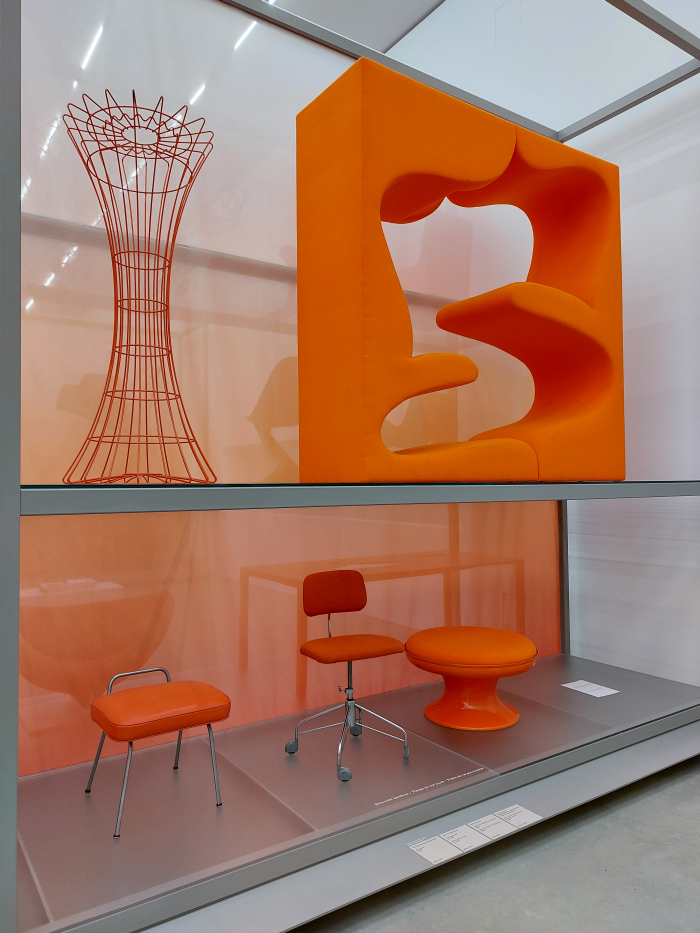
Works in orange, including stool No. 4672 by George Nelson (Associates) (bottom left), as seen at Colour Rush! An Installation by Sabine Marcelis, Vitra Design Museum Schaudepot, Weil am Rhein
…….as we intended to note from Spot On, and thought we had, but have just realised we didn’t, the Vitra Design Museum really should, urgently, consider constructing a raised walkway within the Schaudepot to allow one to visit the uppermost shelves of the display racks, or otherwise reconfigure the shelving, because that which is on the top shelf is essentially absent from the showcase, or put another way, that which is on the top shelf may as well be back its storeroom. At the opening of the Schaudepot we opined of the deficit, “it’s a compromise. But then so is life.” As we get older we may very well be getting less willing to compromise, we wouldn’t put it past us, or with time, and repeated visits to the Schaudepot, and for all through the introduction of the year long special exhibition, the limitation may have exposed itself to be an actual problem that can be solved. What is beyond doubt is that while viewing Colour Rush! the placement of a great many infrequently, or certainly not widely, displayed works high up, where you can’t properly engage with them, niggled; not least because it tends to contradict, almost taunts, the ability of such a re-curation to allow wider access to a museum collection. Brings objects out of their isolation, then hides them tantalisingly almost in view. Among those works one can regrettably only view from afar, and from underneath, we make particular note of the so-called Five-Leaf Chair by George Nelson (Associates), Gabriella by Gio Ponti for Walter Ponti or Berta Rahm’s 1940 chair for Haus Laueli, a work that was also delegated the highest shelf in Spot On. And which we thought we’d expressed our disquiet about then. But clearly the niggling hadn’t reached a critical mass.
And while we’re complaining, a couple more island presentations would have been very welcome. For all we missed brief discussions on, for example, the difference between the physics of colour and the perception of colour, that while any given colour can be exactly defined, it also can never be. Or a brief discussion on the consequences of the different ways of providing colour in context of furniture; that paint, powder coating, different textiles, different plastic colouring approaches et al affect the colour and the perception of the colour, which yes one can approach in the presentation, but which one could also have highlighted through a demonstration with one specific colour, for it’s not unimportant. Not least by way of explaining that colours aren’t definitives, we define them.
Then there is the fact that when we were there, a great many items were at the photographers, but hopefully that’s now resolved itself. And indeed the fact that so many objects were being photographed tends to imply that the Vitra Design Museum are using the opportunity presented by Colour Rush!, and its liberating, when albeit briefly, of a great many items from the anonymity of their storeroom shelf, to expand their online digital collection, which is very, very welcome for it is a most satisfying resource, and the bigger and wider and broader it is, the more useful it is.
And thus underscoring a further advantage of the year long Schaudepot special exhibition concept in enabling the Vitra Design Museum to employ the scope and range and variety of its collection to contribute to the development of understandings and appreciations of furniture design and furniture design (hi)story. Of any temporary exhibition as being something for the museum as much as for the visitor.
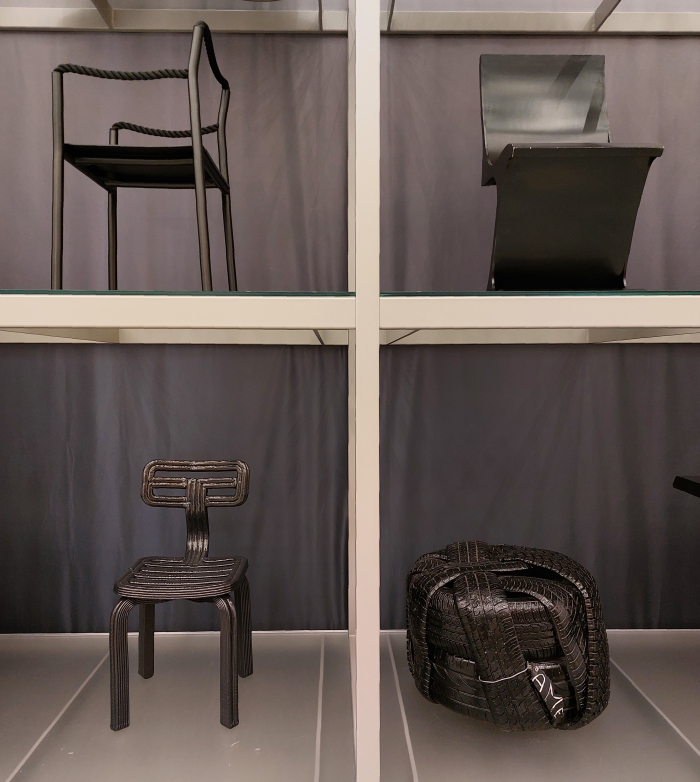
Rope Chair by Ronan and Erwan Bouroullec, Chair Nr. 234 by Heinz & Bodo Rasch, Pouf Tressé by Amadou Fatoumata Ba & Chubby Chair by Dirk van der Kooij (clockwise from top left), as seen at Colour Rush! An Installation by Sabine Marcelis, Vitra Design Museum Schaudepot, Weil am Rhein
Despite the title, as an experience, Colour Rush! isn’t the psychedelic wormhole that was Verner Panton’s 1998 exhibition Light and Colour as recreated in Verner Panton – Colouring a New World at Trapholt, Kolding, there is no sensory disorientation on entering the Schaudepot, it’s a much more sober format, if every bit as efficacious and entertaining.
And every bit as photogenic.
But for all every bit as informative.
Not only in the considerations it enables on the colours of our furniture and interiors, the questioning it demands of the colours of our furniture and interiors, nor only the expanded insights it allows on the (hi)story of furniture design through the presence of the great many designers and objects who normally slumber on archive shelves, but for all in the way it helps underscore that museum permanent collection exhibitions need to be regularly re-organized and re-curated if they are to be meaningful, vital and relevant. If they are to do more than repeat their same old narrative, a narrative which is but a component of the truth, but which over time and repetition will become the truth. Thus narrowing (hi)story. With all the problems that brings.
And also its elucidating that how any exhibtion is curated is important in determining what that exhibition is able to say; the use of a restriction and limitation in the curation, the sharp focus, not only influencing that which Sabine Marcelis was able to select, but helping produce a presentation more expansive, more varied, more informative than would otherwise have been possible. Helping produce a rainbow that, as with all rainbows, delights, stimulates, exists as more than a simple array of colours. And which, as with all rainbows, poses questions whose answers initially appear a lot easier to approach than they subsequently reveal themselves to be. But whose approaching can very much lead you to a metaphoric pot of gold.
And while Sabine Marcelis’s rainbow will, as with all rainbows, pass, the memories of it and the experience of viewing it will endure.
Colour Rush! An Installation by Sabine Marcelis is scheduled to run at the Vitra Design Museum Schaudepot, Charles-Eames-Straße 2, 79576 Weil am Rhein until Sunday May 14th.
Full information, including information on opening times, ticket prices and current hygiene rules can be found at www.design-museum.de
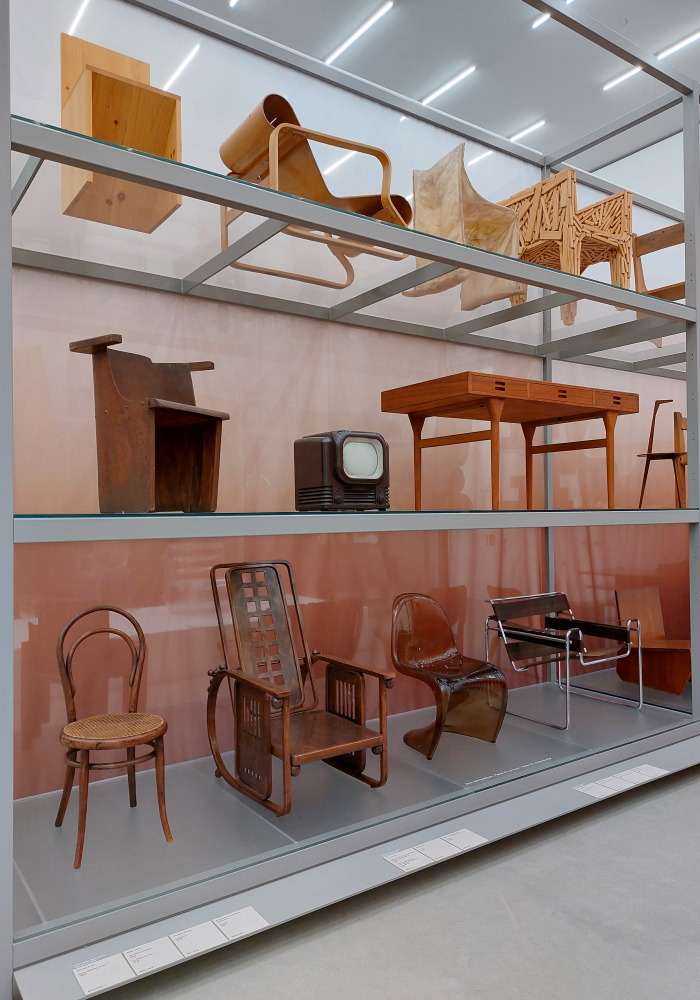
Works in brown, but not all wooden, as seen at Colour Rush! An Installation by Sabine Marcelis, Vitra Design Museum Schaudepot, Weil am Rhein
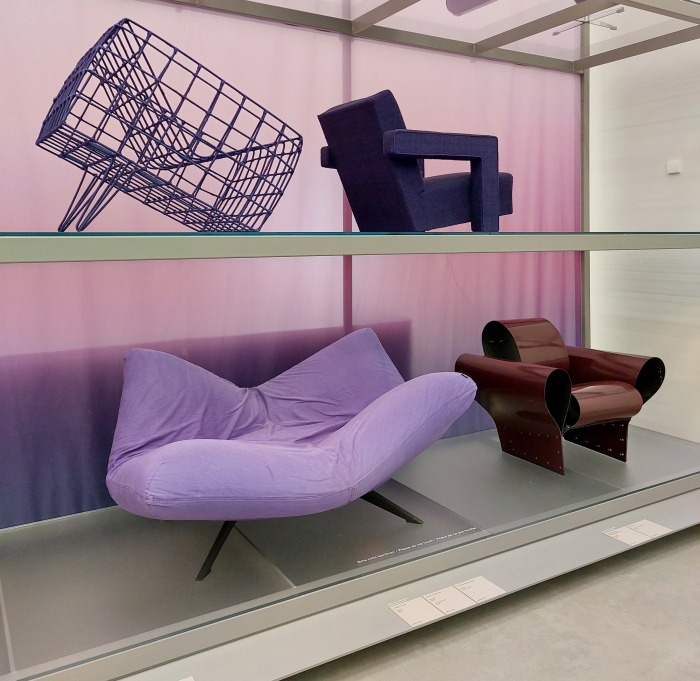
Sansa by Cheick Diallo, an unnamed lounge chair by Gertit T. Rietveld, Bad Tempered Chair by Ron Arad and Ribalta by Fabrizio Ballardini & Flavio Forbicini (clockwise from top left), as seen at Colour Rush! An Installation by Sabine Marcelis, Vitra Design Museum Schaudepot, Weil am Rhein
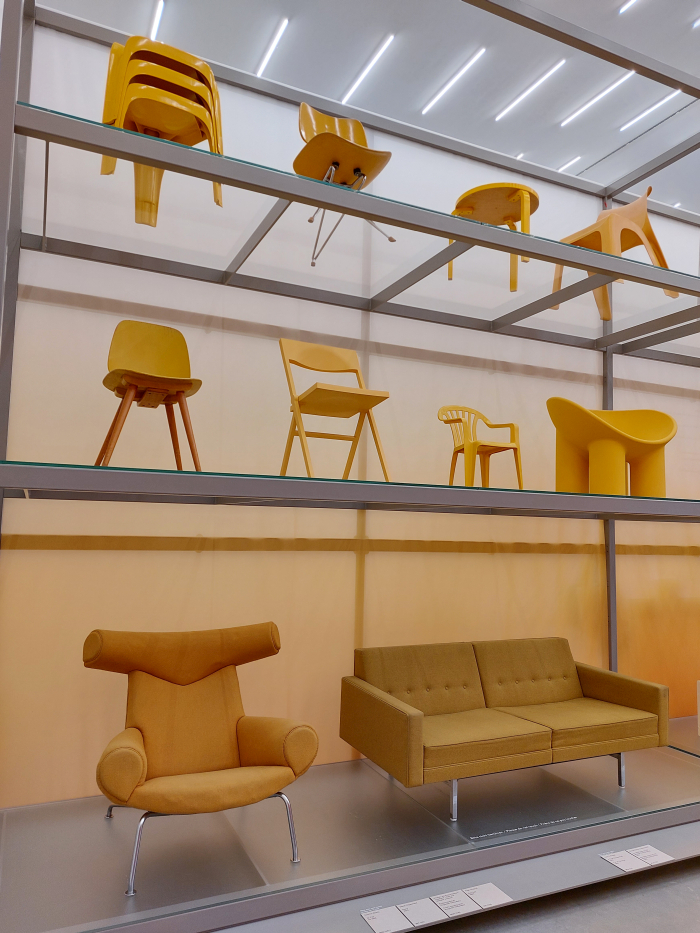
Works in yellow, as seen at Colour Rush! An Installation by Sabine Marcelis, Vitra Design Museum Schaudepot, Weil am Rhein
1. Verner Panton: Meine Design-Philosophie,BÜROszene, Vol 47, Nrs. 1–2, 1995 Original: Können Farben Wohlbefinden erzeugen?
2. At this juncture we are legally obliged to mention the anecdote of Verner Panton designing the interior of Rolf Fehlbaum’s flat in Basel with every room – walls, flooring, furniture, textiles, etc – in one single colour, so a green room, a red room etc… and the brevity of the experiment. A brevity which implies that colours are important for creating a sense of well-being at home. We only know it as an anecdote heard on several occasions, Mathias Remmele implies it is true in Alexander von Vegesack & Mathias Remmele [Eds.], Verner Panton: The Collected Works, Vitra Design Museum, 2000, and not only is Mathias Remmele not the sort of person to wilfully make up such stories, we tend to trust him on all things Panton.
Tagged with: colour, Colour Rush!, Colour Rush! An Installation by Sabine Marcelis, Design. Colour. Theory., George Nelson, rainbow, Sabine Marcelis, Schaudepot, Verner Panton, Vitra Design Museum
